Spin bowlers are such a large part of the game of cricket, yet still we see so many batsmen not being properly prepared to face them. Having a plan of how you’re going to play against spin bowlers is hugely important, whether you’re batting on day 5 of a test match on a turning pitch, or even if you’re playing for your local club side in a T20 game!
If you’re someone who is asking how you can improve your ability to bat against spin, look no further than this post. Here I’m going to explain to you what it takes to be successful against spinners in the modern game. We’ll look at everything including attacking strategies, defensive strategies, the types of shots to play and how to play them. Let’s get into it!
Here are my 10 tips for batting against spin:
- Pick The Length & Commit To Playing On The Front Or Back Foot
- Use The Forward Press
- Learn To Watch The Ball From The Hand To Pick Up The Variations
- Take A Few Deliveries To Get Yourself Comfortable
- Practice Advancing Down The Pitch
- Try To Play ‘With The Spin’ More Often Than Not
- Use A Mixture of Cross-Batted and Vertical Batted Shots
- Try To Dictate The Game To The Bowler
- Kick The Ball Away If It Pitches Outside Leg Stump
- Beware of Fielders Placed Close To The Bat
I’ll now take you through these in more detail!
Pick The Length & Commit To Playing On The Front Or Back Foot
This is the number one key to playing spin bowling effectively. You should always be aiming to pick up the length of the delivery nice and early while the ball is in flight, and then make your final foot movement accordingly. If the ball is full enough that you can stride forward and hit a drive or some kind of similar shot, you could do that. Getting forward like this allows you to smother the spin, you are getting right to the pitch of the ball and striking it before it has chance to spin past your bat! However, if the ball is a little bit too short to get to the pitch of, you’ll want to push onto the back foot and play a back foot shot like the square cut, the back-foot defence or the pull shot. Playing off the back foot like this gives you so much more time to play the ball and try to nudge it into gaps. It also gives you enough time to read the amount of spin on the ball.
The worst kind of position for you to be in as a batsman is what cricketers refer to as ‘getting caught on the crease’. This means that your feet don’t really move forwards or back, they just kind of stay rooted to the spot. If you’re in this position, you probably won’t be close enough to the pitch of the ball, and you won’t be far back enough to give yourself that extra time and play the ball off the pitch. Getting caught on the crease also means that you are much more likely to just prod at the ball with your bat, which is a very risky thing to do against a spinner!
When I’m batting against spin I try to adopt the Kevin Pietersen approach. He says that if you keep playing the spinner off the back foot, this can fool the spinner into thinking that they have to push the ball fuller. For example, if you are getting some good length balls, you could choose to play them off the back foot. A good bowler may see this and think that they need to bowl a fuller one to draw you into a front foot shot. However, they are now likely to push it a little too full and bowl something close to a half volley because you’ve been purposely hanging back! If they bowl this kind of delivery, then you can use this opportunity to launch into a powerful drive! Basically, you can bat in a way that messes with the spinners length. You should always be trying to distract them in ways like this!
One other thing I should mention is that some spin bowlers tend to bowl with a lot of top spin, or over spin. This means that they will usually extract a little bit more bounce from the pitch than other spinners! I would advise you to play spinners like this off the back foot the majority of the time! The extra bounce can lead to you getting hit on the gloves more often when playing forwards, which could result in you being caught by a close fielder!
Use The Forward Press
I always tell batsmen to try and have a positive intent when they’re at the crease. In my opinion, this becomes even more important when you’re facing a spinner. Using the forward press is a great way to inject this positive intent into your game.
The forward press is basically a small forward movement of the front foot that is made just before the spinner delivers the ball. As well as moving your front foot forwards, you should lean forwards slightly over your front knee. This gets your bodyweight moving forwards towards the ball. In my opinion, this is the best position you can get yourself in before you receive a spinning delivery.
Pressing forward in this way is great for us because:
- If we receive a full delivery, we only have to make another small movement towards the ball because we have already pressed forwards onto our front foot. If you hadn’t used the forward press, you would have to make a bigger movement once the ball was in the air!
- If the spinner bowls a shorter delivery, then it’s incredibly easy for you to push back off your front knee and move back towards your wickets. From here you can play an appropriate back foot shot. It’s much easier to press forwards and then move yourself backwards, than it is to keep your weight back and then lunge forwards when the ball is in the air!
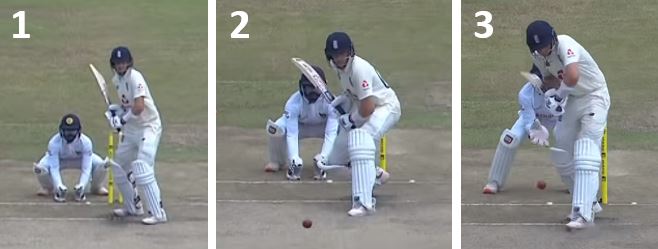
Practice the forward press in the nets and see how it works for you. If you watch the majority of modern professional batsmen play, you can see them use the forward press. Steve Smith is a batsman I love to watch, and you can see him lean forwards and make this very deliberate forward step just before the spinner is about to bowl.
If you want to add the forward press to your game, it’s important to remember to stay light on your feet. This way, you can easily move forwards and back once you pick up the length of the ball. Also, make sure your forward movement isn’t too big. If it is, you could end up unbalanced and that is not a great position to be in.
If you’d like to learn more about the forward press and how it can benefit your game, I’d recommend reading my post that covers it specifically by clicking here!
Learn To Watch The Ball From The Hand To Pick Up The Variations
There are some incredibly skillful spinners in the game of cricket. Some of them can bowl all sorts of tricky deliveries in addition to their normal stock delivery. For example, let’s look at Shane Warne. As well as his usual leg break, he had the googly which spun in the opposite direction. He also had the flipper, which was quick and flat through the air. He also could bowl a top spinner and a slider. Batsmen facing Shane Warne had a nightmare trying to work out all of these different deliveries. If they wrongly identified one of them, it was likely that Warne would make them pay. This is why they had to develop techniques of their own in order to tell which delivery was which.
Learning how to spot each variation is a tough task for even the most experienced batters. That’s why I chose to gather all of my favourite tips and tricks for picking variations and combine them into one 30-page Ebook that I’m now giving away for free! This Ebook contains everything I’ve learned about picking spin bowling, and in it I walk you through the exact methods that professional batters use to do it. In addition to that, I take you through each spin bowling variation individually and show you exactly what you need to look for if you want to pick them! If you’re interested in downloading a copy of this free Ebook for yourself – then click here and head over to my giveaway page. Then, simply follow the instructions to get your copy!
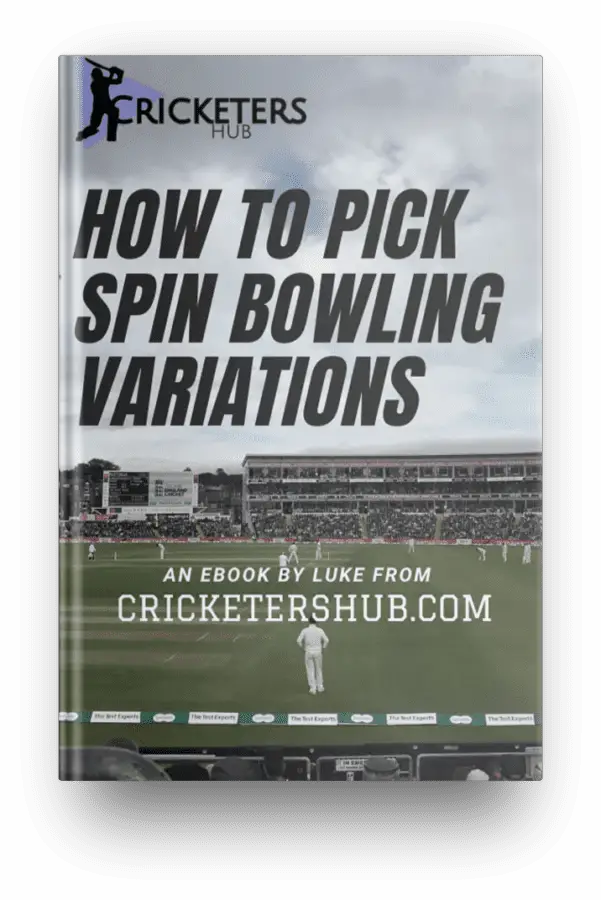
Head over to giveaway.cricketershub.com to get your copy.
If you’re an amateur cricketer, it’s unlikely that players you come up against will have as many variations as Shane Warne, but they may have one or two that they like to bowl. It’s your job to pick these up and be able to defend and attack against them. There are a few different ways that you can identify the deliveries, but one of the most important ones is watching the ball from the spinners’ hand.
I’ve written much more about this in the Ebook, but to summarise it simply here – whenever you face a spin bowler in the nets or in a real cricket match, remind yourself to watch their hand very closely as their arm comes over to deliver the ball. The way they release the ball holds all the information that you need if you want to tell what delivery they have bowled.
In my opinion, there are two main things you can look for:
- Option 1: Try to identify the stock delivery – If you take this option, you will be aiming to watch the bowlers hand and identify the stock delivery. For example, if you are facing a leg break bowler, you will be looking to spot what their leg break looks like. Once you have got a good view of what that delivery looks like, you can spot their variation delivery like the googly by noticing any difference in their hand position. All you have to do is watch the hand and the ball closely, and if there are any differences to the usual stock leg break delivery, you know you’re about to receive a variation.
- Option 2: Train yourself to react to different hand positions – This option is more suitable if you’re facing a bowler that can bowl multiple different variations. Let’s use a leg break bowler as an example again. If a leg break bowler bowls you a top spinning delivery, then their hand will be twisted sideways, with the thumb pointing towards you. A googly will usually result in the bowler pointing the back of their hand towards you. When they bowl their normal leg break you’ll be able to see more of the front of the hand. If you’re facing a very skilful bowler that possesses multiple variations, these are the kinds of cues you will have to learn to pick up.
The stuff I’ve just explained is hard to do! It takes a lot of practice, but reading my Ebook first will give you a lot of helpful pointers! If you want to become a very successful batsman and move up through the ranks of the sport, then you’re going to have to learn how to do this.
Take A Few Deliveries To Get Yourself Comfortable
When a spin bowler begins bowling, I think it’s always a wise idea to take a few deliveries to get yourself adjusted to the pace they are bowling at, as well as the amount of spin and bounce they’re getting out of the pitch. Once you’ve played 3 or 4 deliveries, you should have been able to make a lot of judgements about how much of a threat the spin bowler poses! I think it’s important to take a few balls to get yourself in whenever you first arrive at the crease or whenever you face a new bowler, but it’s especially important when batting against spin.
If you face a few balls and realise that the bowler isn’t getting the ball to spin much, you know you can play in a riskier, more aggressive fashion. It will be less risky to play against the spin, and it’ll also be a lot easier to advance down the pitch to hit the ball. If you notice that the ball is spinning significantly, then you may want to be a bit more cautious, or adjust your shots in order to take the extra spin into account! If you notice the spinner is getting the ball to bounce a lot more than usual, then you may choose to avoid playing cross-batted shots. Cross-batted shots like the sweep are risky to play when the ball is bouncing a lot because it’s very easy to top-edge the ball up in the air!
When the spin bowler bowls their first ball to you, don’t put yourself under pressure to score immediately. Sure, if they bowl you a bad ball or a ball you can easily score off, you should take that chance. But don’t feel guilty about playing out 3 or 4 dot balls. You can launch your attack when that period is over!
Practice Advancing Down The Pitch
Being able to use your feet to skip down the pitch and strike the ball is an incredibly vital skill to have when batting against spinners. If you can do it well, it puts the spinner under a lot of pressure. It will make it a lot harder for them to bowl to you, and make it a lot harder for them to stop you scoring runs.
Most batsmen will take a couple of steps down the pitch, moving them closer to where the ball is bouncing. If all goes well, you will have turned the bowler’s delivery into a half volley, making it much easier to hit wherever you like!
If you’re advancing down the pitch towards the bowler, it’s incredibly important to remember that you don’t have to try to hit a boundary when you get there. If the ball is not in the right place for you to play an aggressive shot, then you can simply use your bat or your pad to defend the ball and wait for the next one! Some batsmen will try to hit a big shot whenever they come down the pitch, and that often leads to mistakes!
If you want to practice advancing down the pitch to spin bowlers, follow these steps:
- Get a coach or a partner to stand at the other end of the pitch and throw some underarm deliveries towards you. Ideally, you want the deliveries to bounce around 2 metres in front of your feet. As the ball is in flight, advance down the wicket towards where you anticipate the ball is going to bounce. Once you feel like you are in a good balanced position, strike the ball with your bat.
- Our next step is to make the drill a little harder. This time, your partner won’t be throwing the ball underarm, they’ll be throwing it overarm almost like a normal spinner would be. This gives you a little bit less time to react and move your feet as the ball will be travelling a little faster. You should do exactly the same as in step 1 for this stage, move your feet and try to move yourself towards the pitch of the ball before striking it.
- The final stage is facing a real spinner who will be trying to make it difficult for you rather than just aiming for one spot on the pitch. Make sure you practice this movement a lot against real spin bowlers in the nets before you start trying it in real matches. You want it to feel totally natural before you take it in to a game situation.
To sum this section up, remember the following:
- You don’t have to attack the ball after coming down the pitch! If the ball isn’t in the right spot, just defend it and move on to the next delivery.
- When moving down the pitch, you should be aiming to get your front foot slightly to the leg side of where the ball is going to bounce. This gives you enough space to bring your bat through and strike the ball.
- As you advance towards the bowler, try to move in a straight line, and try to keep your stumps covered. Moving in a straight line is the quickest route to your final point, and covering your stumps ensures that you probably won’t be bowled! Even if the ball hits your pads, you’re not likely to be out LBW because you’re so far down the pitch.
If you’re interested, you can find more of my batting footwork tips in the post linked here!
Try To Play ‘With The Spin’ More Often Than Not
It is a lot easier to hit a cricket ball in the direction that it is spinning, than the opposite direction. For example, a right arm off break bowler will look to turn the ball in towards a right handed batsman’s body. This means the ball is spinning in the direction of the leg side. This means it is much easier for that right handed batsman to hit the ball ‘with the spin’ in to the leg side. Similarly, a right arm leg break bowler will be looking to spin the ball away from right handed batsmen, or towards the off side. Therefore, it is easier for these batsmen to hit the ball ‘with the spin’ through the off side.
If the ball is turning in towards your body, then this gives you the most options as a batsman. You can easily nudge the ball into the leg side for a single. There may be a lot of fielders positioned on the leg side, so you will have to learn to use your wrists in order to pick the gaps. It is also much easier to hit big shots into the leg side, so the ball spinning towards you means you have a real opportunity to do that. If the ball is spinning away from you, then you have a few main options: You can leave the ball, you can drive the ball into the cover region, you can wait for the bowler to drop a shorter delivery and then play the square cut, or you can play the reverse sweep. All of these options are a little risky, but if you pick up line and length well then you should be fine!
If you choose to hit against the spin regularly, you’re making batting a lot more difficult for yourself. There is a lot more margin for error when you do that! For example, if you’re a right handed batsman facing deliveries that are spinning away from you, you have to hit your shot perfectly in order to smack the ball into the leg side. There is a much bigger chance that you’ll either miss the ball altogether, hit it up in the air, or edge it to a fielder!
However, hitting against the spin can often be more rewarding. The fielding captain is less likely to have fielders on that side of the pitch, meaning that if you hit a good shot, you’re extremely likely to pick up runs. If you do choose to hit against the spin make sure you’re getting right to the pitch of the ball, or getting right back in your crease and using a cross-batted shot!
Use A Mixture of Cross-Batted and Straight Batted Shots
The more shots you can play against a spinner, the harder it is for them to bowl to you. It also makes it harder for the opposing captain to set a field for you!
It’s vital that you’re able to hit down the ground against spinners, as well as through the cover and mid-wicket regions. To hit the ball through these areas, you’re going to be using a straight bat and playing drives and flicks off your pads. This is a safe way to play, and if you get your front foot out to the pitch of the ball you can score a lot of runs using this method. However, you don’t want to become too one dimensional! I’ve watched a lot of cricket in my time, and batsmen who just lunge forwards ball after ball and try to play the ball somewhere down the ground are very easy to keep quiet. It’s far too easy to set fields to them and dry up their flow of runs. The batsmen who have more variation in their game and are able to hit square of the wicket just as regularly as they hit down the ground are the scariest batsmen for spinners to bowl to.
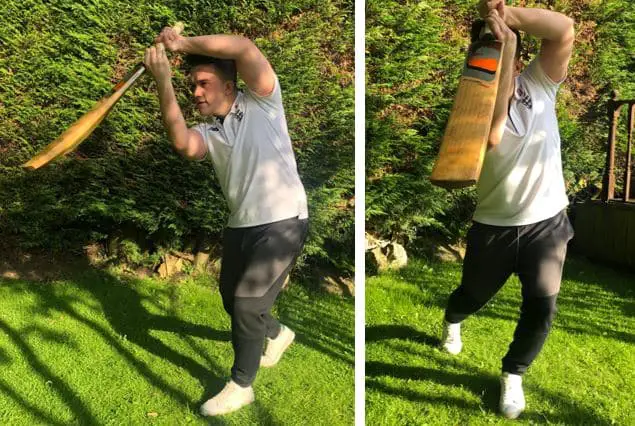
Therefore, I’d recommend putting a lot of effort into improving your sweep shot, and your reverse sweep shot. These shots allow you to play on the front foot but hit the ball behind square, rather than down the ground. If you notice that the fielding side don’t have anyone positioned behind square on either side of the wicket, these shots are a great option. You’ll pick up a lot of runs by using them! They are also great to use on wickets where the ball is spinning a lot more than usual. Pitches like that make it difficult to play with a straight bat!
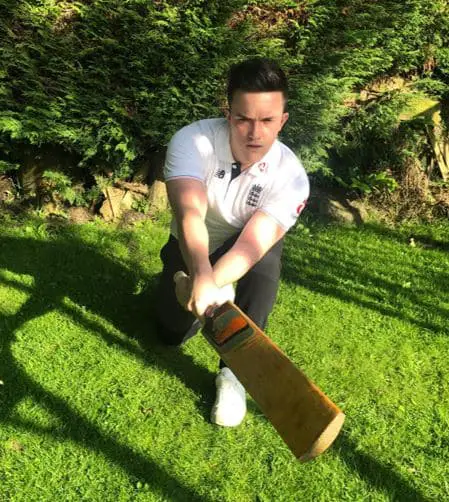
As I mentioned earlier in the post, you should also be waiting for any delivery from a spinner which is slightly short. These are the easiest spinning deliveries to put away for a boundary. As soon as you see the ball is short, you should rock back on to the back foot and play a square cut shot if the ball is outside the line of the off stump. If the ball is on the line of your body or towards the leg side, rock back and play a forceful pull shot, or a simple tuck into the leg side. Making sure you practice these kinds of shots in your net sessions will make you a much more effective player in real match situations!
Try To Dictate The Game To The Bowler
When you’re in a battle with a spin bowler, it’s important to not allow them to settle into a rhythm of bowling exactly where they want to. Spinners love nothing more than being able to bowl their line and lengths and land ball after ball in the same spot, while a batsman plays defensively. The worst thing for a spinner to bowl against is a batsman that takes calculated risks and puts them under pressure. This makes it harder for them to find a bowling rhythm!
So how can you put dictate the game to a spinner and put them under pressure? Basically, it’s all about not letting them achieve what they want to achieve. For example, if they have fielders positioned close to the bat at silly point and silly mid-on, you can start to play more aggressively in order to try and move those fielders. Close fielders are perfect for when a batsman is playing defensively as there is a high chance the ball will pop up to one of them off the bat. However, when you are slog sweeping, or playing big booming drives towards the silly point fielder, they will be trying to get out of the way of the ball instead! After you’ve hit a few boundaries, the fielding captain may choose to re-think those field placings.
Similarly, if the fielding team has the majority of their fielders up in the inner circle of the field trying to stop the singles, then you should be aiming to hit the ball over the top of those fielders. With the quality of cricket bats today, you don’t even have to connect with the ball perfectly to hit it over the infield! Once you hit a couple of shots over the top of these fielders that are trying to stop the singles, the opposing captain will probably push them further back to the boundary. One they make that move, you can run as many singles you want after hitting the ball in their direction.
Another thing I’m constantly checking when playing against spin is if there are any fielders behind square on the off-side or the leg-side. If there aren’t, then sweeps and reverse sweeps are a great option, and you’ll force the fielders to move to cover that shot.
To sum this section up, you should always be trying to put spinners off their game plan by doing what they don’t want you to do. The more you do this, the more frustrated they will get, and the more bad deliveries they will give you.
Kick The Ball Away If It Pitches Outside Leg Stump
This tip is very simple and it centres around one key rule of cricket: A batsman cannot be out LBW if the delivery pitches outside the line of their leg stump.
Many spin bowlers will try to land the ball in the area just outside your leg stump and then spin the ball across your body. They will usually choose to do this for a couple of reasons:
- It is a defensive tactic – they will position plenty of fielders on the leg side and try to frustrate you.
- The area just outside a batsman’s leg stump often gets roughed up by bowlers bowling from the other end of the wicket. A spinner that lands the ball in this area will usually get much more spin than if they land it on a smoother area of the pitch.
If you see a spinner using this tactic, or even if you just notice a random delivery bouncing outside the line of your leg stump, be aware that you cannot be out LBW. This means that you can defend the ball comfortably with your pad. You will often see a lot of professionals use their pads to deflect the ball away from the stumps without even offering a shot! This allows you to frustrate the bowler as they will be hoping that you play a shot! If you choose to use your pad in this way, try to get your gloves well out of the way. The last thing you want is the ball accidentally hitting your gloves and you getting out caught like that!
Also, remember that if you see the ball pitch outside the line of your leg stump, you can play any shot you like as long as you’re sure that you’ve got your body in the way of your stumps! As I said, you could not be out LBW, so if you try to slog sweep the ball and it hits you in front of middle stump, there are no consequences! If I see a spinner go to that tactic, I often try to go down on one knee in front of the stumps and sweep/slog sweep a few balls for boundaries. This usually stops the bowler in their tracks!
I remember Kevin Pietersen once saying that he loved it when spinners would try to land the ball outside his leg stump. He said he knew that the only way they could get him out by using this tactic would be due to a big mistake from him! If you see a spinner bowling in a similar way to you, use this tip to your advantage!
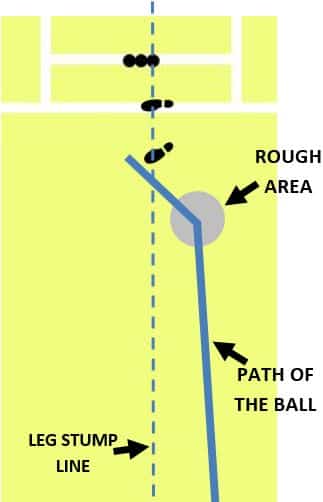
Beware of Fielders Placed Close To The Bat
A common method of attack that spin bowlers use against batsmen is to place fielders close to the bat while forcing the batsman to play defensively. If the batsman mistimes their defensive shot, or accidentally gets an inside edge on to their front pad, the ball can pop up in the air and be caught by one of these close fielders!
If you’re batting and you see fielders being placed close to you, I’d recommend trying to play with ‘soft hands’. This basically means that you don’t force your hands towards the ball. Instead, you try to play passively and allow the ball to hit your bat. Playing in this way means that if you do make a mistake, the ball is less likely to carry to a fielder!
When you do play defensive shots on the front foot with these fielders close to the bat, I’d advise you to play with your bat out in front of your pad, rather than playing with your bat alongside your pad like many players do. I think you’re much more likely to get a costly inside edge onto your pad if you play with bat and pad together!
As we discussed earlier, if you feel an aggressive approach is suitable for the position you find yourself in, play a few attacking shots. Fielders close to the bat don’t like batsmen playing aggressively because it puts them at risk, and captains don’t like it because they have less fielders that are able to stop runs/boundaries. A few well timed aggressive shots can help get rid of the close fielders fairly quickly!
Conclusion
The most important part of improving your batting against spin is experience. You need to be in the nets facing spin bowlers regularly. If you can do that, then that is a great platform. You can then use these practice sessions to work on the things that I’ve outlined in this post! If you can put these tips into action, you’ll find yourself being much more confident when it comes to taking on the slower bowlers.
